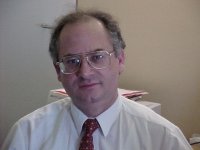
Domenico Santucci


| [1681-1776] - | [1776-1861] - | [1861-1945] - | [1945-1995] |
Telegraph and telephone spread rapidly after the Civil War. Following Samuel Morse's development of the telegraph in the 1840s, the state was interlaced by a network of telegraph lines. Alexander Graham Bell's telephone was first demonstrated publicly at the Philadelphia Centennial Exhibition in 1876. By the end of the century, the telephone had become universal. Pennsylvanian Daniel Drawbaugh claimed to have invented a working telephone 10 years before Bell, but his claim did not hold up in patent litigation. The Commonwealth now has thousands of miles of telegraph and telephone lines and almost 10 million telephone.
Pennsylvania played a key role in the development of a major 20th-century contribution to the dissemination of ideas and information the radio. The first commercial broadcast station in the world was KDKA in Pittsburgh, which started daily schedule broadcasting on November 2, 1920. The first church service broadcast by radio occurred on KDKA a year later, and the first public address by radio was made by Herbert Hoover at the Duquesne Club in Pittsburgh in 1921. Radio quickly became a fixture in most homes, but lost its dominance in the broadcasting market with the advent of television in the 1950s.
Philadelphia, which had been the theatrical capital of America before 1830, continued to be a leader in music publishing and piano manufacture and was the birthplace of American opera. Edwin Forest, Joseph Jefferson, the Drews, and the Barrymores were important stage actors in the late 1800s and the early 1900s. The first all-motion-picture theater in the world was opened on Smithfield Street in Pittsburgh on June 19, 1905, by John P. Harris and Harry Davis. The term "nickelodeon" was coined there. The Warner brothers began their careers in western Pennsylvania.
In 1790, there were only three institutions of university or college rank. Today there are almost 200 institutions of higher education, a majority of which were founded after 1865. Most higher education before 1900 was sponsored by churches. The development of higher education for women, the broadening of the curriculum, and the decline of purely denominational control were important trends of the 20th century.
Pennsylvanians also led in invention and the application of science in industry and daily life. John A. Roebling, who came to America in 1839 and spent most of his active life in Pennsylvania, led in the development of steel wire rope and steel bridges, and his engineering work was carried forward by his son Washington. William Kelly (1811-1888) exhibited leadership in invention. Edward G. Acheson (1856-1931), chemist and inventor, contributed to the development of carborundum as an abrasive and graphite as a lubricant. Henry P. Armsby (1853-1921), director of the Pennsylvania State University Agricultural Experiment Station, was internationally known for his contributions to nutritional science. Edgar Fahs Smith (1854-1928) of the University of Pennsylvania was a leading American chemist and helped to found the American Chemical Society. In the field of medicine, the Hahnemann Medical College, Jefferson Medical College, and the University of Pennsylvania Medical School made Philadelphia one of the outstanding medical centers of the nation. Medical colleges were established at the University of Pittsburgh in 1885 and at Temple University in 1901. These institutions made noteworthy contributions to medical science.
John A. Brashear (1840-1920) of Pittsburgh was important in the development of astronomical precision instruments which made great contributions to knowledge. The inventor George Westinghouse (1846-1914), while not a native of the state, spent the greater portion of his life here. The earliest successful experiment of Thomas A. Edison with electric lighting was made in Sunbury. John R. Carson (1887-1940) and Dr. Harry Davis (1868-1931), of Pittsburgh, were notable for contributions to the development of radio. Elihu Thomson (1853-1937), one of the founders of General Electric, continued the Franklin tradition in electrical science. The world's first computer was developed at the University of Pennsylvania. In recent times, the engineering schools of the state's universities and such institutions as the Franklin Institute and the Mellon Institute have placed Pennsylvania in the forefront of modern industrial research and invention.
Altogether, there were 130 generals and admirals from Pennsylvania. More Medals of Honor were awarded to Pennsylvanians than to citizens of any other state. There were 40 military and naval installations in Pennsylvania, including two large camps, Indiantown Gap and Camp Reynolds. All the Army's doctors received training at Carlisle Barracks, and the Navy's photographic reconnaissance pilots were instructed at the Harrisburg Airport. The Philadelphia Navy Yard built two of the world's largest battleships and many lesser vessels. Among a dozen military depots in the state were Mechanicsburg Naval Supply Depot, Middletown Air Depot, Letterkenny Ordnance Depot, Frankford Arsenal, and the Philadelphia Quartermaster Depot.
Pennsylvania's industrial resources made it "the Arsenal of America." Planes, tanks, armored cars, guns, and shells poured out of its factories. Ships were launched in the Delaware and Ohio Rivers and on Lake Erie. Steady streams of war goods flowed over its railroads and highways. Pennsylvania oil lubricated the machines of war, and its coal kept the steel mills going. Food from its fields fed war workers and soldiers. In total war production Pennsylvania ranked sixth among the states, in shipbuilding fifth, and in ordnance fourth. It furnished almost one-third of the nation's steel. More money was spent to expand production capacity in Pennsylvania than in any other state. Three hundred Pennsylvania firms were honored with production awards.
Pennsylvanians paid over two billion dollars a year in taxes and were second only to New Yorkers in the purchase of war bonds. Under the leadership of the State Council of Defense, more than a million and a half people were organized to protect the state against enemy attack and to aid in the war effort.


